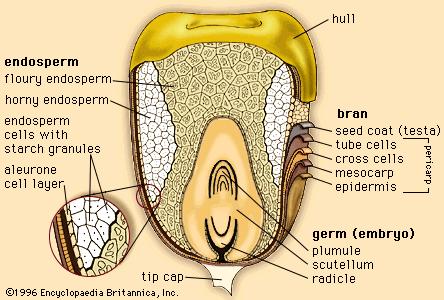Kernel growth stages
| Stage | Growth stage | Days after silking | Approx. moisture |
|---|---|---|---|
| R1 | Silking | 0 | n/a |
| R2 | Blister stage | 10-14 | 85% |
| R3 | Milk stage | 18-22 | 80% |
| R4 | Dough stage | 24-28 | 70% |
| R5 | Dent stage | 35-42 | 55% |
| R6 | Maturity | 55-65 | 30% |
R2: Blister stage
The kernel ovule has been pollinated and is beginning to grow by cell division. The kernel contains an embryo (tiny immature plant that will germinate once planted) and an endosperm that will provide the energy needed for the seed to germinate and emerge from the soil.
R3 & R4: Milk and dough stages
The kernels are now well into a period of rapid starch accumulation which results from sugars made from photosynthesis in the leaves being shipped down to the kernel where they are converted into starch. Cell division within the kernel (endosperm) is mostly complete (the embryo or immature corn plant is still growing). Growth of the kernel at this point is mostly due to cell expansion and filling of the cells with starch. The purpose of starch in the endosperm is to provide an energy source for the germinating seedling, however, it also makes a good source of starch for many other purposes.
Final yield depends on number of kernels that develop AND the final size and weight of the kernel.
R5: Dent stage
At R5, all of the kernels are dented and the shelled cob is dark red in colour. The kernels are drying down now. Dry down begins at the top of the kernel where a small hard white layer of starch is forming. This starch layer appears shortly after denting as a line across the kernel. As the kernel matures, the hard starch layer and line will advance toward the base of the kernel (toward the cob). The accumulated starch is hard above the line, but still soft below the line.
R6: Mature stage
R6 is reached when all of the kernels on the ear have attained their maximum dry weight (or maximum starch accumulation) and is commonly measured by the presence of black layer. The black layer forms once the hard starch layer has advanced completely down the kernel to the cob which causes a black abscission layer to form at the base of the kernel. Black layer formation in the kernels begins at the top of the cob and works its way down the ear. Black layer formation signals the end of kernel growth for this season.
The husks and many leaves on the plant are no longer green at this stage. The average kernel moisture content at R6 is 30-35%, however this varies considerably between hybrids and environmental conditions. The grain is not yet ready for safe storage, which requires 13-15% moisture level for shelled corn.
Most farmers choose to let the crop dry down partially in the field, and the rate of field drying depends on the hybrid and environment.
Sources: Holly Loucas, Customer Agronomist, Dow Seeds; Nielsen, R.L. 2001. Grain Fill Stages in Corn; Purdue University. http://www.kingcorn.org/news/timeless/GrainFill.html; http://www.soilcropandmore.info/crops/Corn/How-Corn-Grows/



